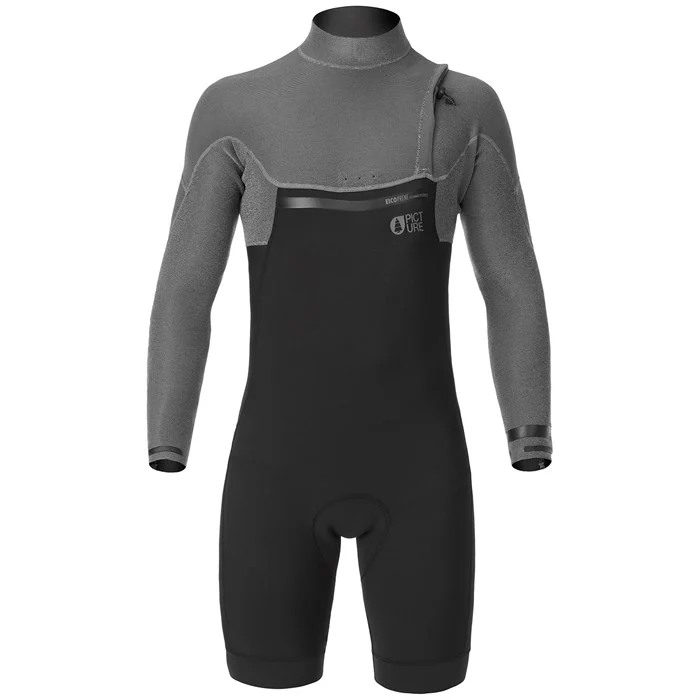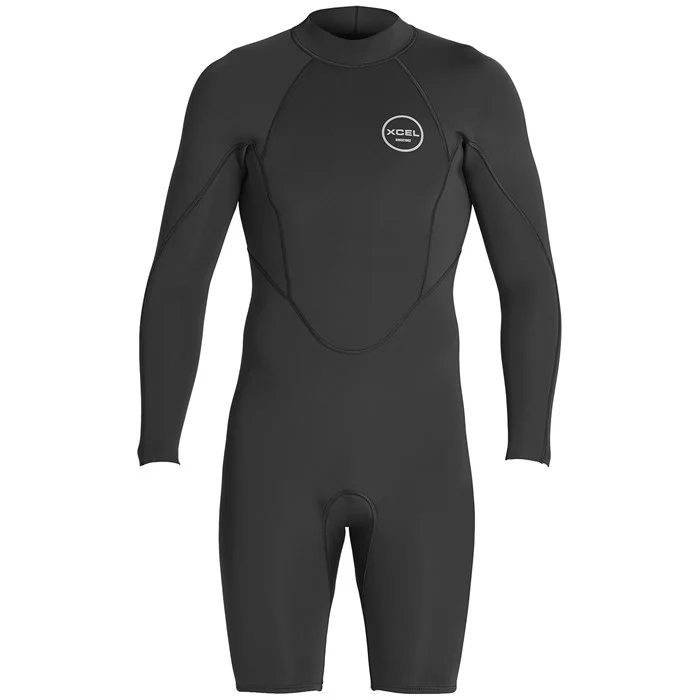
When it’s too cold for boardshorts and too warm for a full wetsuit, reach for a springsuit. Photo: Ella Boyd//The Inertia
The waves are epic. But a bit lully. Or the breeze has a chilly bite to it. Or the sun is dropping low in the sky, the waves are drenched in golden light, and you can’t tear yourself away from this joyous spectacle, even though you’re shivering. Whatever the case may be, you’re cold. But the water is too warm for a wetsuit, and evidently too cold for a pair of boardshorts. So where to turn? Time to break out the springsuit.
Springsuits, also known as “shorty” wetsuits, bring you a bit of extra warmth when it’s needed without the cumbersome bulk of a wetsuit, by using thinner neoprene and shortening the arms and legs, or chopping them off altogether. They provide the ideal balance of insulation and performance surfers need for spring and summer in temperate climates—or for tropical winters. Yep, it gets cold even in Hawai’i, where we’ve tested a fresh batch of springsuits on O’ahu’s North Shore through the dying days of winter to bring you this 2024 update. For full details, as well as fit and sizing info, see our How We Tested section.
For ease of comparison, we tested only long arm/short leg springsuits. For more info on different types of springsuits, see our Buyer’s Guide. And to see how the suits stacked up against each other, check out our Comparison Table. Our awards weigh basic features—such as key storage, zipper types, wrist/thigh cuffs—against fit, comfort, flexibility, warmth, and durability, as well as sustainable materials, which, taken together, will provide all the information you need to find your perfect springsuit. For women’s options, here’s our guide to The Best Women’s Springsuits.
The Best Men’s Springsuit Wetsuits
Best Overall: Patagonia Yulex Regulator Lite
Most Flexible: Picture Organic Meta Flexskin
Best Value: Vissla High Seas II
Best Budget: Xcel Axis
Warmest Springsuit: Manera Seafarer Hybrid
Best Overall
Patagonia Yulex Regulator Lite ($269)
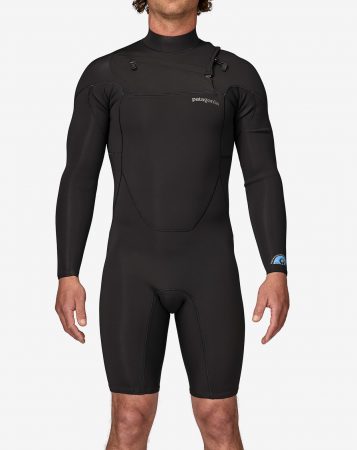
Available In: Long Sleeve/Short Leg, Short Sleeve/Short Leg, Short Sleeve/Long Leg, Short John, Long John.
Fit: Front-zip w/ chest key loop. Wrist and thigh cuffs. Slightly roomy through waist/legs.
Sustainability: High – Yulex.
Pros: Warm, stretchy, sustainable. Excellent warranty and repair program. Least bulky/intrusive chest zipper that we tested. Lots of different cuts/style options.
Cons: Weird thigh cuffs. Limited availability in some sizes.
Can surfing be redemptive? Perhaps not, but each of us does have the ability to do our part not to succumb to wholesale aquatic degeneracy. Put simply, we can – and ought – to buy sustainable surf gear. But until recently, neoprene noticeably outperformed Yulex in surfing wetsuits. That is no longer the case. With all the warmth, flexibility, comfort, and durability you expect from a premium wetsuit — along with industry-leading sustainable manufacturing and fair trade practices — Patagonia’s new Regulator Lite Spring Wetsuit is our award winner for Best Overall Springsuit.
In prior testing, opting for a sustainable springsuit meant sacrificing flexibility and comfort. After the latest redesign (Fall 2023), the Regulator line’s blend of Yulex and chlorine-free synthetic rubber (with recycled nylon and spandex linings) finally achieves the stretchiness and performance surfers crave. Plus, the low-profile (and non-corroding) Riri asymmetrical zipper notably set this suit apart from the other front-zip models in terms of unimpeded paddling. The other prior complaint against Patagonia was the price premium, but for springsuits this only amounts to about $25 more than some other high-end models. Considering the durability of Yulex, and Patagonia’s 3+ year warranty, we find this to be a worthy investment.
One quibble, however, is that the Regulator Lite runs slightly large in the waist, hips, and legs. The arms, chest, and shoulders of this suit fit well (see note on the fit guide above), but the hips and leg openings weren’t as form-fitting. This didn’t affect the warmth or performance of the suit, but for those with skinny legs and caught between sizes, consider sizing down. Lastly, the lining is cozy enough, but isn’t as luxurious as, say, Xcel’s Comp X or O’Neill’s Hyperfreak.
All things considered, our Best Overall winner offers everything you want in a springsuit while also pushing the performance boundaries of sustainable materials. The Regulator Lite offers a better combination of warmth, flexibility, comfort, and durability than any of the competition — and it does so while also letting you sleep at night.
Check Price on PatagoniaMost Flexible
Picture Organic Meta Flexskin ($180)
Available In: Long Sleeve/Short Leg, Short Sleeve/Short Leg
Fit: No-zip w/ no place for a key. Form fitting. Neck, thigh, and wrist gaskets/cuffs.
Sustainability: Medium – limestone neoprene.
Pros: Great paddling comfort and flexibility.
Cons: Least warm suit we tested. The no-zip entry/exit can be difficult. No key storage.
Picture Organic is a brand rooted in the mountains that has recently taken its sustainable ethos and competitive prices to the world of surfing. And we’re glad they did. We’ve loved their wetsuits for several years now and the Meta springsuit is no exception. It’s super comfortable, stretchy, and the no-zip entry makes for unrestricted paddling. Gaskets at the neck, wrists, and thighs keep water out, but the ultra stretchy Flex Skin panels on the arms and chest definitely sacrifice warmth in exchange for the unparalleled flexibility and paddling comfort which have earned this suit our Most Flexible award.
One issue with the fit: since it’s a no-zip, even as flexible as it is, pulling the neck flap overhead can be quite difficult. If you have neck and/or shoulder injuries or flexibility issues, we’d recommend a front-zip, or in extreme cases a back-zip. Our lead tester has a plethora of old battle wounds and wrestled a bit with this suit’s entry/exit system, but did find it to be significantly more flexible than the other no-zip we tested (Rip Curl’s E6 E-bomb). Also, mind-bogglingly, there’s no key loop or pocket!
Picture Organic’s proprietary EicoPrene foam and recycled liners give this suit a decent level of sustainability, but limestone-derived neoprenes still require extractive practices and energy-intensive chemical processing. We suspect Picture will deploy a Yulex wettie before long, but for now their sustainability bona fides compare well to some of the legacy wetsuits we tested.
If you run hot and/or want to prioritize paddling comfort (and you don’t have any neck/shoulder issues) the Meta Flexskin is a fantastic option.
Check Price on Picture OrganicBest Value
Vissla High Seas II ($200)
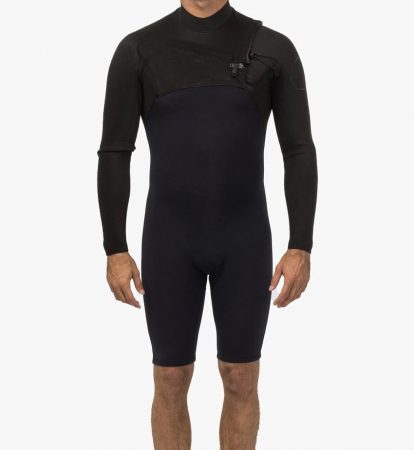
Available In: Long Sleeve/Short Leg, Short Sleeve/Long Leg.
Fit: Front-zip w/ chest key loop. Form fitting, but loose thighs. Wrist cuffs.
Sustainability: Medium – limestone neoprene.
Pros: Solid all-around, mid-range springsuit. Moderate sustainability.
Cons: Loose legs bunch up, bulky across the chest.
Vissla bills themselves as a creative, innovative surf company that’s committed to environmental stewardship. After testing their High Seas II springsuit, featuring their Ridiculous Rubber, we’re inclined to agree. Here, they’ve deployed a limestone neoprene blend that delivers high-end comfort and performance at a mid-range price. As one of the more affordable front-zip options, there’s a lot to like here, but the chest closure and zipper is on the bulky side, and the legs were loose enough that they bunched/rolled up at times—slender surfers beware.
Barring the common bulky-zipper issue (that only Patagonia has solved for front-zips) and quirky leg fit, Vissla’s High Seas II is our Best Value suit with a good balance of warmth, flexibility, comfort, and sustainability at a good price.
Check Price on AmazonBest Budget
Xcel Axis ($140)
Available In: Long Sleeve/Short Leg, Short Sleeve/Short Leg, Short John.
Fit: Back-zip w/ interior back key pouch. Slightly short arms and legs. No wrist cuffs.
Sustainability: Medium – limestone neoprene.
Pros: Very affordable, reasonably warm and flexible.
Cons: Back-zip and wrists flush regularly. Very aggressive velcro on neck flap.
Xcel’s Axis line of springsuits provide some of the best bang for your buck when all you’re looking for is a bit of neoprene to ward off the chill. As a budget suit, the Axis line features no-frills construction: flatlock stitching, a back zip, and a basic, but comfortable lining. Due to the back-zip, slightly short sleeves, and lack of wrist cuffs, we found the suit to flush regularly. The neck closure also features some super aggressive velcro that will bite into anything it touches.
While our Best Budget award winner doesn’t provide the same high-tech stretch or comfort as a premium suit, it’ll save you about $100, and its limestone neoprene will do what a springsuit is made to do: keep you warm in chilly waters without hindering your performance.
Check Price on EVO Check Price on Amazon
Best of the Rest
Xcel Comp X ($245)
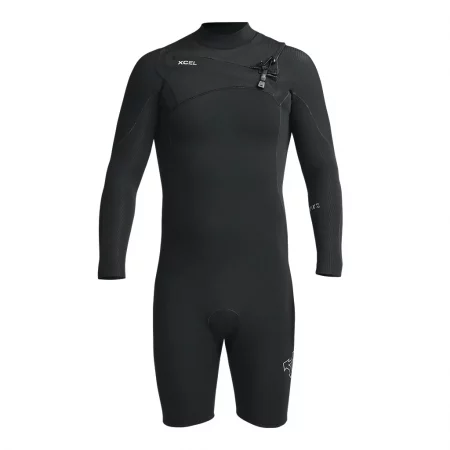
Available In: Long Sleeve/Short Leg, Short Sleeve/Short Leg, Short Sleeve/Long Leg.
Fit: Front-zip w/ chest key loop. Slightly short arms. No wrist/thigh cuffs.
Sustainability: Medium – limestone neoprene.
Pros: Toasty, stretchy, and insanely comfortable lining.
Cons: Excessively burly zipper, magnet zipper clasp, wrists flush in bigger surf.
Xcel’s premium Comp X line features a newly designed Channel Flex exterior and Thermo Dry Celliant infrared lining, which combine to give this springsuit as comfortable a fit as any that we tested. The suit is flexible enough that the front-zip panel is easy to pull overhead and the arms and shoulders move freely while paddling. The suit’s uber-stretchy material and slightly short arms do, however, make the wrists prone to flushing and bunching up a bit in bigger surf. Also, the front zipper is so thick that the Comp X is a bit bulky across the chest and its magnet closure doesn’t hold as securely as a button snap.
Lastly, Xcel has committed to taking sustainability seriously by going neoprene-free by 2026; they currently feature limestone neoprene and recycled linings in all their suits. Keep an eye out for a fully-sustainable model in the next year or two.
Altogether, the Comp X is a fantastic springsuit with a couple subpar features that keep it a notch below our award winners.
Check Price on EVO Check Price on Amazon
O’Neill Hyperfreak ($245)
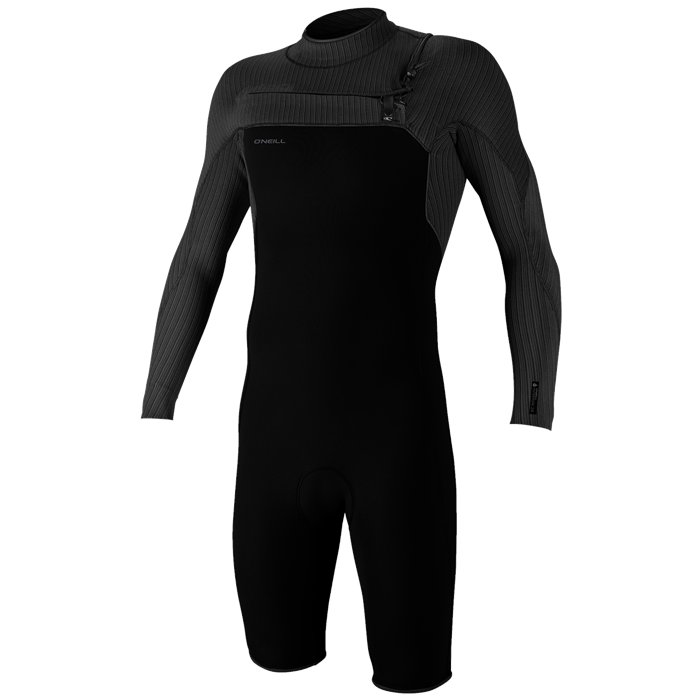
Available In: Long Sleeve/Short Leg, Short Sleeve/Long Leg, Short Sleeve/Short Leg.
Fit: Front-zip w/ leg key pouch. Form-fitting, tight arms. No wrist/thigh cuffs.
Sustainability: Medium – 90% recycled (factory offcuts) limestone neoprene with recycled oyster shells and eco carbon black.
Pros: Super comfortable and flexible neoprene with a cozy lining.
Cons: Slightly restrictive chest zip. Not a standout in terms of durability.
No, we haven’t forgotten about O’Neill’s great Hyperfreak springsuit, our 2023 Best Overall winner. Its Technobutter lining gives it one of the most supple, comfortable fits (along with Xcel’s Comp X line) on the market. It’s warm, flexible, and form-fitting, without being restrictive thanks to the super stretchy neoprene. However, the suit’s plush comfort does come at the expense of some durability, which is always a bit of a tradeoff when it comes to such stretchy and comfortable neoprene.
In terms of performance, the Hyperfreak’s paddle comfort suffers a bit due to the thicker zipper (as opposed to Patagonia’s Riri zipper), snap closure, and drawstring which — combined with the extra neck-closure flaps — make the chest/neck a bit tight. It does do a great job of keeping out water as a result, however. While the significant upgrades to Patagonia’s springsuits and their top-notch sustainability pushed the Regulator Lite series to the top this year, the Hyperfreak remains one of the best springsuits on the market thanks to their top-notch neoprene, cozy lining, and great fit.
Check Price on Amazon Check Price on O'Neill Wetsuits
Rip Curl E6 E-Bomb ($230)
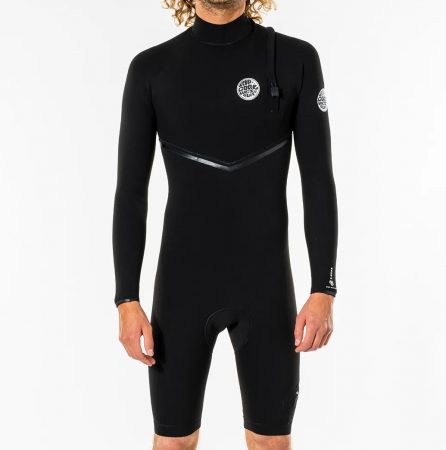
Available In: Long Sleeve/Short Leg, Short Sleeve/Long Leg, Short Sleeve/Short Leg.
Fit: No-zip w/ thigh key pocket. Form fitting, narrow across shoulders. Neck, thigh, and wrist gaskets/cuffs.
Sustainability: Low – petroleum neoprene.
Pros: Very warm E-bomb lining. No-zip entry is comfortable across the chest.
Cons: Not super flexible, a struggle to get in/out of. Lining isn’t particularly comfortable. Poor thigh key pocket placement.
Rip Curl’s E6 E-Bomb features a no-zip entry and a streamlined fit (which we loved) to minimize flushing and make it one of the warmer suits we tested. That said, the fit is a bit too narrow across the shoulders and the E6 neoprene doesn’t stretch as well as many of the other suits we tested, making it a bit of a struggle to get in and out of the E-Bomb. Again, those with neck/shoulder injuries: beware the no-zip entry. The lining also wasn’t as comfortable as other premium springsuits—or even many of the mid-range suits. Lastly, the key pocket placement (on the lower thigh) caused enough friction that a stashed car key stabbed through the neoprene within a few uses.
These are a lot of drawbacks for a wetsuit made from old-school, petroleum-based neoprene. While Rip Curl offers a wetsuit recycling program, the industry as a whole is trending toward using more sustainable materials at every step of the production process.
Although it’s not an award winner, for the slender surfer (with no neck issues) seeking a warm, form-fitting springsuit, the E-Bomb is a solid option.
Check Price on AmazonFinisterre Nieuwland ($210)
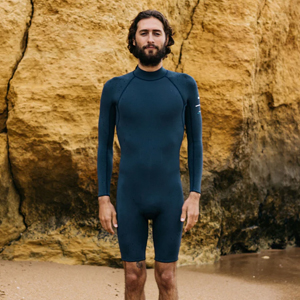
Available In: Long Sleeve/Short Leg, Short Sleeve/Long Leg, Short Sleeve/Short Leg.
Fit: Back-zip w/ no key loop/pocket. Short arms, roomy fit for a M. No wrist/thigh cuffs.
Sustainability: High – Yulex.
Pros: Warm, sustainable, and durable.
Cons: Stiffer and less flexible than Patagonia’s Yulex. No key storage!
Thanks to the folks across the pond at Finisterre, Patagonia isn’t the only name in Yulex wetsuits. These blokes even “ship products to [their] warehouse by land and sea, using less carbon-intensive journeys and avoiding air freight wherever possible.” Suffice to say they take sustainability SERIOUSLY. Designed for British summers, but plenty warm enough for Hawaiian winters, we found the Nieuwland 2e to offer the warmth, durability, and sustainability of Yulex at a mid-range price.
That said, it’s definitely not as comfortable, stretchy, or flexible as Patagonia’s revamped Regulator line. And, as with all back-zips, there was often flushing while duck diving, etc. Also note that the fit was a bit wonky, with short arms and a roomy lower half—and there’s no key storage. On the upside, the back-zip and velcro closure make Finisterre’s Nieuwland a great, environmentally friendly option for anyone with mobility issues.
Check Price on FinisterreWarmest Springsuit
Manera Seafarer Hybrid ($299)
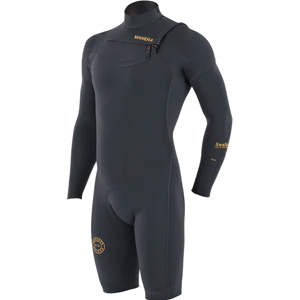
Available In: Long Sleeve/Short Leg.
Fit: No key loop/pocket. Great fit and thigh cuffs.
Sustainability: Medium – limestone neoprene and recycled materials.
Pros: 3/2 construction was the warmest “springsuit” we tested.
Cons: It’s basically a 3/2. No key loop.
It almost feels like cheating to give the award of “warmest springsuit” to the Manera Seafarer Hybrid when they went ahead and simply added an extra mm of neoprene to the torso, but then again, nobody else is doing it. The Seafarer Hybrid is a classic springsuit (long sleeve, short leg) with 3mm of neoprene on the torso, and 2mm on the arms for paddling. A thin and comfortable jersey on the inside of the suit completes the fit without adding any extra warmth, honestly a good thing. I often found myself running a bit warm in testing on the North Shore of Oahu during December.
The suit is also available in a short sleeve/long leg version (titled the Manera Seafarer Steamer SS, and included below) however it’s worth noting that the Steamer SS is made completely of 2mm neoprene, without the 3mm of warmth in the chest area. If you really want that level of warmth without the sleeves, just buy a 3/2 Seafarer and cut the sleeves off.
Check Price on Backcountry Check Price on Amazon
Manera Seafarer Short Sleeve Hybrid ($319)
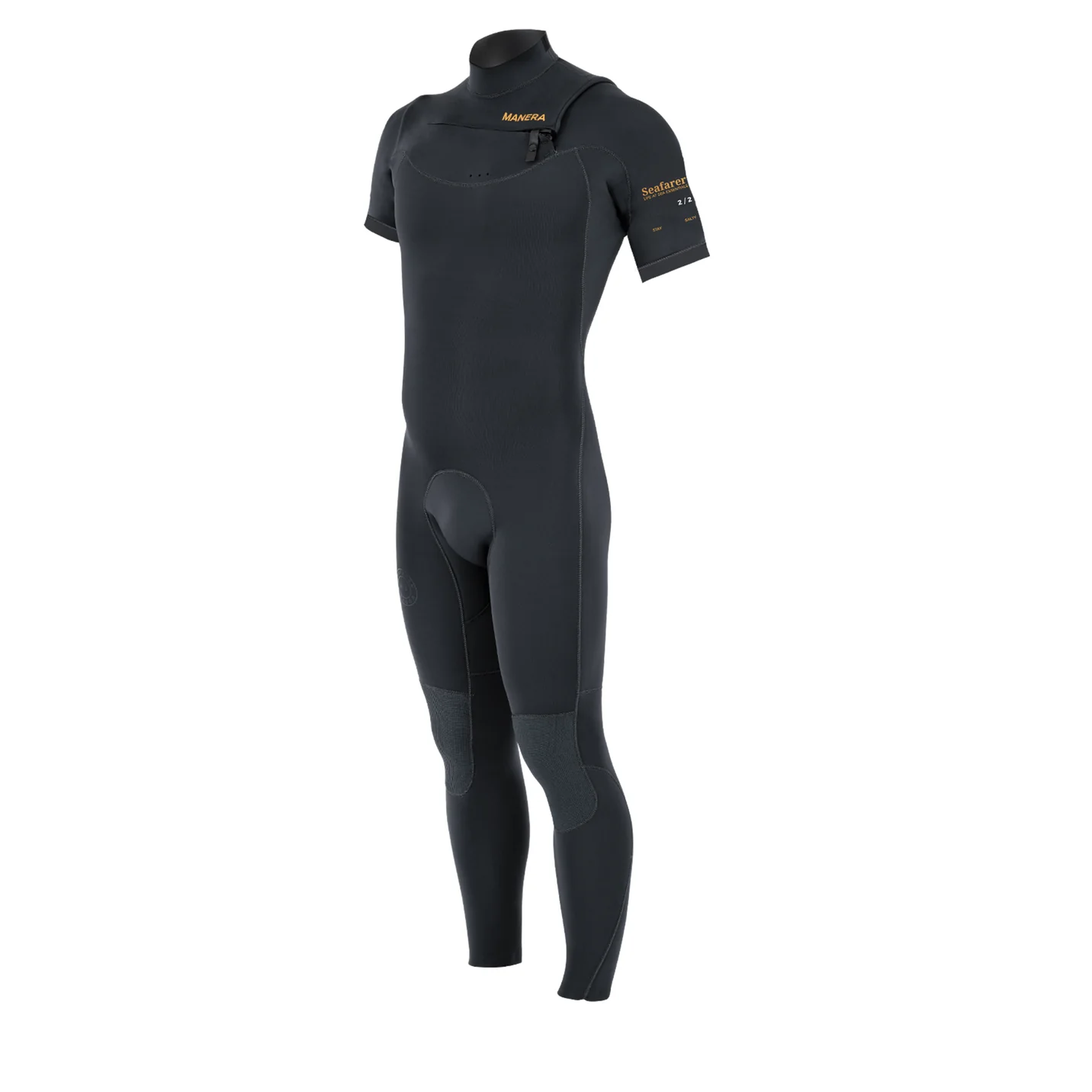
Available In: Short Sleeve/Long Leg.
Fit: No key loop/pocket. Great fit and lightweight neoprene.
Sustainability: Medium – limestone neoprene and recycled materials.
Pros: Super light and flexible short sleeve fullsuit in 2/2mm construction.
Cons: No key loop. Pricey.
The Manera Seafarer has been a longstanding favorite suit of ours in the wetsuit department, and when it comes to springsuits, the Seafarer Short Sleeve Hybrid does not disappoint. Unlike its long sleeve/short leg sibling, above, the suit features 2mm of neoprene throughout, and a very thin (and comfortable) interior jersey, leading to a light and unencumbered experience. That said it runs on the colder side of things. Which can be a good thing. If you’re looking for the rash protection of a short sleeve hybrid springsuit in waters where you’d normally be wearing something lighter (and less protective) this is a great option.
Check Price on Backcountry
Testing the Xcel Comp X on the North Shore of Oahu. Photo: Sarah Shaw//The Inertia
Best Springsuits Comparison Table
| Springsuit | Price | Sustainability | Closure |
| Patagonia Yulex Regulator Lite | $269 | High | Front Zip |
| Picture Organic Meta Flexskin | $180 | Medium | Zip Free |
| Vissla High Seas II | $200 | Medium | Front Zip |
| Xcel Axis | $140 | Medium | Back Zip |
| Xcel Comp X | $245 | Medium | Front Zip |
| O’Neill Hyperfreak | $229 | Medium | Front Zip |
| Rip Curl E6 E-Bomb | $230 | Low | Zip Free |
| Finisterre Nieuwland | $210 | High | Back Zip |
| Manera Seafarer Hybrid | $299 | Medium | Front Zip |
| Manera Seafarer Short Sleeve Hybrid | $319 | Medium | Front Zip |

Some of the best springsuits, testing in progress. Photo: Michael Bishop//The Inertia
How We Tested The Best Springsuits
We first published this guide in 2023, after testing 7 springsuits on O’ahu’s North Shore. For our 2024 update, new lead tester and North Shore local Mike Bishop tested 8 different springsuits by paddling out into the chilliest and windiest waves an O’ahu winter could throw at him, including plenty of dawn patrols and sunset marathon sessions. With water temps hovering around the low 70’s (but wind chills dipping into the 60’s!), he wasn’t able to push the lower temperature boundaries of these suits, but he was always comfortably warm when many other surfers were shivering, complaining, and cutting their sessions short. To consistently rate warmth and comfort, he only tested long-sleeve springsuits in size medium. He tested a variety of front-zip, back-zip, and no-zip models and included fit notes to help you decide which is best for you.
Testing surf gear in Hawai’i may seem like the best gig this side of the pro tour (it certainly has its perks), but committing to dawn patrols and sunset sessions lasting into twilight, day after day, no matter how sore, tired, or surfed-out you may get, is not for the faint-hearted. Trust us, it takes a special kind of workaholic to pull this off on a deadline.
A quick note on the fit guides presented herein: Our lead tester is 5’10”, about 145 lbs, has a 31” waist, and has long arms (ape index +4). While he could’ve probably fit into size S (or the rarely-available ST) from some manufacturers, he opted to wear size M across the board. Keep this in mind during discussions of fit and sleeve length. Also be sure to check each manufacturer’s size guide before making a purchase.

The Manera Seafarer Hybrid was easily the warmest springsuit we tested. Photo: Ryan Foley//The Inertia
Best Springsuits Buyer’s Guide
Different Types of Springsuits
When it comes to springsuits, there’s a lot of different suit styles, all dependent on which part of the wetsuit got chopped off to make it a “springsuit,” along with a whole host of different names and abbreviations for each. When it comes to abbreviations, “SS” signifies “Short Sleeve,” “LS” for “Long Sleeve”, with SL and LL for “Short Leg” and “Long Leg,” respectively.
The classic “shorty” wetsuit has short sleeves and short legs. However, the most popular springsuit style you’ll find out in the water is the long sleeve, short leg suit which is what we focused on in this review for ease of comparison. The opposite style (short arms, long legs) sacrifices a bit of upper-body warmth in exchange for upper-body mobility and lower-leg warmth and rash protection.

The classic short leg/long sleeve springsuit. Photo: Sarah Shaw//The Inertia
Other styles of springsuit include the “long john” or “farmer john” wetsuit, which has the arms completely cut off at the shoulders. These suits are popular with kayakers, as well as longboarders for the unrestricted arm-movement and ease of paddling. A popular choice at longboard breaks like San Onofre in the summer is a long john suit paired with a wetsuit jacket, perfect for quick transitions on days of variable sun, or when the wind picks up.
In the warmest of waters, some will even choose a “short john” – a long john suit with the legs cut short above the knee. While they don’t offer a ton in the way of springsuit warmth, they do provide the rash protection of a wetsuit in key areas like the chest and stomach, without any restrictions to one’s movement.
Springsuit Materials and Sustainability
Like many things in the surf industry, the neoprene in wetsuits and springsuits isn’t the easiest on the environment. Classic neoprene is derived from, you guessed it, fossil fuels, namely oil. Classic neoprene does provide some of the best stretch out there, but it comes at a cost to our planet.
Limestone neoprene (top-tier limestone neoprene is also referred to as Yamamoto neoprene), prized for its lightness and flexibility, has a reduced environmental impact, using calcium carbonate from limestone instead of crude oil, but it still needs to be extracted from the earth, and requires a lot of energy to be transformed into neoprene.

Picture uses a blend of limestone and recycled materials for their wetsuits. Photo: Paul Ferrese//The Inertia
Yulex neoprene, popularized by Patagonia and derived from natural rubber, used to be the lowest-performing option, with less stretch than other types of neoprene. However, in Fall 2023, Patagonia released a new line of wetsuits which have wildly increased stretch, on par with all but the stretchiest neoprene. The search for the perfect combination of flexibility, comfort, warmth, and durability now tilts towards Patagonia’s Yulex blend, especially when accounting for sustainability.
Other companies are taking note. Manera, Billabong, and Quiksilver recently announced their own Yulex wetsuit lines and Xcel has committed to going neoprene-free within the next couple years—all of which signals an industry-wide shift towards environmentally friendly materials. To wit, recycled linings, oyster shell processing, eco carbon black, dope-dyed yarn, and water based glue have been so widely adopted that they’re no longer noteworthy.
Additionally, more and more wetsuit manufacturers are turning to recycled blends to create their neoprene—with material from scrap tires, pulverized oyster shells, and other recycled bits blended with (in most cases) limestone neoprene. Performance-wise, we’ve been super impressed with these recycled neoprene blends, particularly those from O’Neill, Xcel, Vissla, and Picture Organic in their most recent springsuits.

Patagonia’s springsuits received a major upgrade in the past year and their Yulex material is now on-par with neoprene for performance. Photo: Sarah Shaw//The Inertia
Features to Look For in a Springsuit
Key Pouch/Key Loop
Ahh, the wetsuit key loop. In our opinion, a good loop or pouch is something that every wetsuit should have, yet somehow that’s STILL not the case. There’s very little difference between having a key loop or a key pouch, mostly coming down to personal preference. However, if you use a waterproof pouch for your electronic key fob while surfing, there’s a chance you’ll want to choose a suit with a key loop in the chest zipper rather than a pouch on the leg, so you can be sure that key fob fits.

No-zip suits are great for paddling comfort and keeping water out, but can be difficult to get on. Photo: Sarah Shaw//The Inertia
Zipper-Style
Do you prefer a back-zip or a front zip? What about a no-zip? The options for various styles of entry abound. Each has their characteristic flaw: back-zips flush with water easily, front-zips feel bulky/restricted across the chest, and no-zips are notoriously difficult to get into and out of. It’s worth noting here that the main concern for back-zips among wetsuits—letting water in—is much less of a problem with warm water and springsuits. If you’ve been itching to get back in a back-zip, now might be your time to shine.
Neoprene Thickness
Sure, 2mm is basically the industry standard when it comes to springsuit wetsuits, but that doesn’t mean it’s the be-all, end-all. Some suits like Manera’s Seafarer Hybrid go with a 3/2 construction for added warmth, and some go with thinner materials for greater flexibility.

Patagonia creates their suits from sustainable Yulex neoprene, and now they’re stretchier than ever. Photo: Ryan Foley//The Inertia
Future Updates
If you’ve made it this far, thanks for reading. We’ll be doing our best to keep this article updated as wetsuits go in and out of stock online. We will also keep you posted as we’re able to try any new wetsuits or if any durability problems arise.
Editor’s Note: Looking for something warmer? Here’s our guide to The Best Wetsuits. If a springsuit is too much, consider trying a pair of boardshorts and a wetsuit jacket. For more gear reviews and features on The Inertia, click here.


